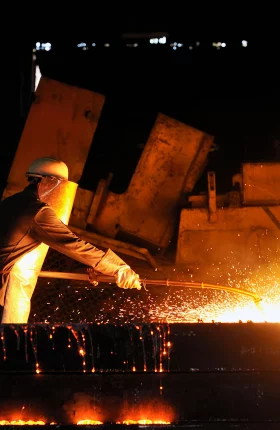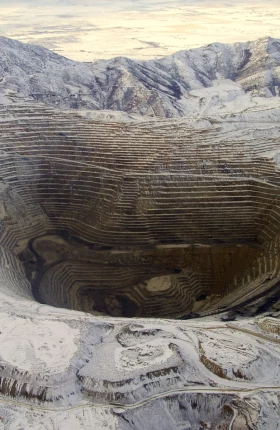Mining, those in the business will tell you, is not like other industries. Companies operate across geographically dispersed and remote locations, and working conditions can be severe and unpredictable. Indeed, there is an extraordinary amount of variability, from the weather to the quality of the ore. And little of it can be controlled. Mining teams, often far-flung, have a hard time working together in a system, much less an optimized one.
For a long time, miners have simply accepted this lack of efficiency as a fact of life. But does that really have to be the case? No doubt, mining companies could better coordinate their operations if they more resembled manufacturing companies. Manufacturers can integrate their assembly processes under one roof and more easily target, control, and reduce variability—such as by improving the way they manage suppliers and train their employees. For miners, it’s not so simple. How does one control the weather? Or know for sure what is in the ground?
Not surprisingly, no one has yet figured out how to make mining more like manufacturing. But we think that prospect is no longer out of reach. Certainly, mining operations aren’t going to take place under one roof, but processes could be integrated end to end, and variability could be managed better. So while a mining company may never look like a manufacturer, it could nonetheless run like one. The key to this approach lies in something mining companies have already started to embrace: automation.
To date, the industry has utilized automation mainly to optimize discrete subsystems within the mining value chain. In Australia and South America, for example, companies are starting to move to autonomous operations, piloting driverless trucks and drills and studying the use of driverless trains. But these discrete improvements, while welcome, only hint at the possibilities. If more machines across the value chain were connected via the Internet, for example, data on performance and conditions could be collected and sent to a central control center. (See The Rise of Robotics , BCG article, August 2014.) If this information were then fed into software with an optimizing algorithm, decision making could be transformed, because software can process far more variables than humans—and far faster, too. So the variability in mining could be better accounted for, resulting in more informed, and ultimately more successful, responses.
That such end-to-end optimization is now a realistic aspiration is due to five key technology trends:
- Low-cost, network-connected sensors and actuators
- Increasingly powerful on-board control systems in machines
- Ubiquitous high-speed network connectivity across mining operations
- Scalable, low-cost computer processing and data storage
- The advanced algorithms and off-line analytics of big data
Together, these trends empower the so-called Industrial Internet, through which different machines in different locations can interact with each other, allowing companies in the mining industry to better link and coordinate their operations. Given recent developments in the market, this ability has not come a moment too soon. Declining ore grades, lower commodity prices, and rising labor costs have squeezed margins over the past several years. Total shareholder return, meanwhile, has dropped markedly for the top ten producers, and even more for companies outside that tier. (See Value Creation in Mining 2013 , BCG report, May 2014.) For producers large and small, improving productivity is essential.
But if mining companies are to create a manufacturing-like system where processes are coordinated, linked, and optimized end to end, then they need to change the way they approach automation. Deployments shouldn’t be ad hoc, implemented in projects that focus solely on specific steps in the value chain. What is needed, instead, is a holistic strategy for integrated automation: a clearly articulated vision for the role, extent, and purpose of automation across the entire value chain.
Developing this strategy is no simple thing. But by concentrating on several key areas—the scope of automation, the implications of more data, the role of vendors and standards, the protection of intellectual property (IP) and cybersecurity, and the challenges of implementation—mining companies can put themselves in the best position to craft an integrated automation strategy that fits their needs and circumstances. Keep in mind, too, that this is not a short-term effort. The transformation of mining that we propose is still at least five—perhaps even ten—years out. But that’s all the more reason to start planning and take the steps today that could lead to leaps tomorrow.
The Scope of Automation
Integrated systems can help mining companies coordinate far-flung operations, anticipate and avoid potential problems, and respond faster to disruptions. That’s powerful stuff. But it can also seem overwhelming. What tools and processes—in what places, in what order, in what time frame—are needed?
Eat the elephant one bite at a time. End-to-end integration isn’t going to happen overnight; it will need to be developed piece by piece. So companies will want to start with the pieces that offer the greatest rewards—the parts of the value chain in which automation will have the biggest impact, such as by increasing utilization at bottlenecks.
At the same time, it’s crucial to think about how these initial projects will interact with what’s coming down the road. This is what makes the holistic approach to automation different from the ad hoc approach: You’re always thinking about how any given project fits into the big picture. To this end, a roadmap is essential. So, too, is an awareness of technical standards. You want to be sure that the technology you’re putting in the field will be able to integrate with the technology you’re putting on the agenda.
Laying the technical groundwork, however, is just the beginning. Companies also must champion integrated automation to break through any cultural and organizational resistance. This means clearly defining and articulating outcomes and potential benefits. And while a long-term goal, such as a fundamental reset of the cost base, may be the real prize, companies will need to identify short-term benefits, too, such as more localized asset productivity. Early tangible benefits will be instrumental in sparking the funding that the overall effort will require.
The Implications of More Data
Automated equipment with on-board sensors will generate a great deal of data. Thanks to increasingly fast networks and less-expensive storage, this information can be readily transmitted to, and retained by, a mining company. Big-data tools and analytics provide powerful new ways to make use of this data; for example, by identifying patterns in a machine’s performance that signal an impending catastrophic failure. (See The Industrial Internet: Six Critical Questions for Equipment Suppliers , BCG article, October 2014.)
But analyzing data and drawing insights can be complex tasks that often call for new skills. In many cases, these skills will be unfamiliar to mining companies, and the required talent will have to be actively developed internally or attracted from outside. Either way, mining companies must determine how to support and nurture these professionals, and that can be trickier than they might expect.
Experts brought in from outside, particularly from the digital-savvy startups that excel in data science and analytics, may be used to working in a faster-paced, more entrepreneurial environment. They may also be accustomed to having leeway to experiment and to do things in new and unproven ways. Mining companies will need to minimize culture clash and spur innovation. One way to do both is to embrace more of the agile ways of software development, which is built around experimentation, an acceptance of failure—because it happens early, doesn’t cost much, and offers lessons to draw on—and short, iterative cycles.
The opportunities that big data presents to mining companies will be extensive. But realizing them will require investments in time, effort, and resources, as well as a willingness to try novel and untested approaches. Companies will have to decide just how big an investment they should make. They’ll have to weigh the potential benefits of using data against the costs of doing so. And they’ll have to assess the price of not using data, too.
The Role of Vendors and Standards
To date, mining companies have largely let vendors take the leading role on automation, allowing them to develop and position products instead of setting priorities and goals themselves. While there are benefits to this approach—such as productivity improvements, even if just modest ones, without much management effort—there are risks, as well.
Equipment vendors naturally tend to take a vertical view. Their goal is to “own” a complete process, such as autonomous haulage, by providing the entire IT stack: everything from sensors and actuators through control systems and human-machine interfaces to data-historian and business-intelligence solutions. Accordingly, vendors tend to focus far less on horizontal integration with adjacent steps in the value chain. But that horizontal integration is crucial for mining companies, which prefer open standards that allow them to combine the offerings of multiple vendors and link together all the discrete elements of production. In this respect, the goals of vendor and miner often conflict.
Moreover, ceding too much control to vendors may mean ceding too much of the value that is ultimately created. The data generated by sensor-laden equipment, for example, has potential value for vendor and mining company alike. If vendors control the access to this data, not only could they utilize it on their own—and perhaps create lucrative new revenue streams that they will not share with the mining companies—but miners may have a harder time obtaining and using that data for their own improvements to safety and production.
Still, mining companies are not technology companies, and they have little interest in acting as such. So when they need to partner with vendors, they should make sure that the relationships are balanced. Applying technical standards can be extremely helpful here, enabling miners to benefit from a vendor’s expertise without ceding too much control of the resulting innovations or getting locked into vendor monopolies. But standards raise some difficult questions. What role should mining companies play in the standard-setting process? When in the innovation process should standards be introduced? Setting them too early, before the full business potential of a technology has been identified, could discourage further experimentation and stifle innovation. But setting them too late could allow for wasteful investments in solutions that do not fit the standards that the rest of the industry will ultimately accept. The key, we’ve found, is to pursue standardization once best practices have emerged.
Protecting Intellectual Property and Cybersecurity
Whether developed entirely in-house or in collaboration with vendors, innovations can create competitive advantages that will need to be protected. This can be accomplished through establishing intellectual property rights. For mining companies, the question is no longer whether to invest in those rights, but how much to invest in them.
Yet companies—in all industries—often miss a crucial consequence of securing IP rights: just as your IP rights can keep competitors at bay, so can their IP rights bar you from potential routes to growth. We already see mining companies partnering with leading automation vendors and developing patents together. A holistic automation strategy, then, doesn’t just look to protect IP, but to keep a close watch on the competition. It needs to identify lock-out risks and to steer efforts and resources accordingly. No one wants to follow in the footsteps of one international oil producer that learned this lesson the hard way: the company was suddenly forced to halt development on a valuable new production technique—and write off a very significant investment—when a competitor obtained a patent after independently developing the same technology.
Cybersecurity can be another source of concern, particularly when automated systems—running over networks and storing data, perhaps in the cloud—are used in business-critical operations. (See Cybersecurity Meets IT Risk Management: A Corporate Immune and Defense System , BCG Focus, October 2014.) Utilities, for example, have realized new efficiencies and opportunities for value creation since they began deploying smart meters on their electricity grids. But at the same time, they’ve had to address security risks brought by the convergence of information technology and operational technology. For example, IT security chiefs are increasingly reporting to CIOs at utilities. Mining companies that embrace automation will reap rewards, too, but just like utilities, they will have to identify and reduce risks. This means more than deploying appropriate software and hardware. It requires changes to the organization.
The Challenges of Implementation
We believe that automation, integrated across the value chain, can unlock significant benefits for mining companies, such as improved asset productivity and reduced waste. But it will also change the way the business and its people work. That raises important considerations. For one thing, software would be making decisions instead of humans in many situations. Initially, these individuals will likely feel that they are giving up the parts of their work they value most—and that’s a potential problem.
But companies can quickly dispel those concerns. Instead of making reactive decisions based on situations that have already occurred, mining personnel could be looking to where problems might appear in the future and take steps to prevent them. So in the long term, their responsibilities would actually increase—as would their value to the company’s operations.
Another issue to consider as automation becomes more widespread is the impact on industrial relations. Here the automotive industry highlights both sides of the coin: overall, the industry has been a case study for the benefits of wide-scale automation, but for decades, labor disputes constrained automation’s expansion, particularly in the United States.
Certainly for some workers, automation means short-term pain. But in the long run, it creates different types of jobs into which people may transition. Companies need to do a certain amount of balancing, weighing the impact of automation on some workers against the improved productivity and competitiveness it ultimately will bring to the broader organization.
That automation has a place in mining is indisputable. The question is how pervasive its role will be. The holistic approach to automation is based on the idea that mining companies can aspire to the levels of discipline and efficiency maintained by manufacturers. Miners can now better understand, anticipate, and react to all the uncontrollable variation in the business. And they can do it because technology has begun to enable end-to-end integration of scattered operations and faster, better-informed decision making. The ultimate vision of mining may not yet be a reality, but it is no longer a fantasy, either. Mining companies should start taking the steps to realize that vision now.








